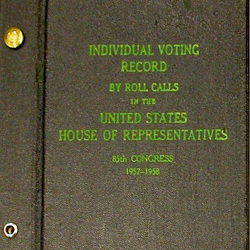Historical Highlights
The House Sets a Record for Roll Call Votes Prior to Electronic Voting
October 08, 1968
 Individual Voting Records, 85th Congress (1957–1959), Collection of the U.S. House of Representatives
Before electronic voting, House tally clerks hand wrote each Member's vote on a tally sheet, compiled into folios such as the one pictured above.
Individual Voting Records, 85th Congress (1957–1959), Collection of the U.S. House of Representatives
Before electronic voting, House tally clerks hand wrote each Member's vote on a tally sheet, compiled into folios such as the one pictured above.
Related Highlight Subjects
Fast Facts
Beginning in 1844, electronic technology fashioned an information transformation in Congress. The telegraph, telephone, radio, television, and computer revolutionized the way information was disseminated from the halls of the House of Representatives.
More >Fast Facts

The House has elected or appointed employees to carry out a wide variety of tasks throughout its history. The officers’ duties are prescribed both by law and Rule II of the Rules of the House of Representatives.
More >







